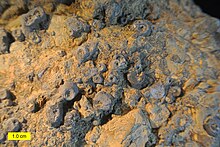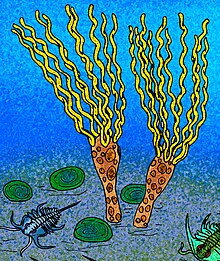The Eocrinoidea were an extinct class of echinoderms that lived between the Early Cambrian and Late Silurian periods. They are the earliest known group of stalked, brachiole-bearing echinoderms, and were the most common echinoderms during the Cambrian.
| Eocrinoidea Temporal range:
| |
|---|---|

| |
| Eocrinoid holdfasts (Middle Ordovician, Utah) | |

| |
| Colourful reconstruction of Gogia ojenai | |
| Scientific classification | |
| Domain: | Eukaryota |
| Kingdom: | Animalia |
| Phylum: | Echinodermata |
| Subphylum: | †Blastozoa |
| Class: | †Eocrinoidea Jaekel, 1899 |
| Groups included[1] | |
| |
| Cladistically included but traditionally excluded taxa | |
| |
The earliest genera had a short holdfast and irregularly structured plates. Later forms had a fully developed stalk with regular rows of plates. They were benthic suspension feeders, with five ambulacra on the upper surface, surrounding the mouth and extending into a number of narrow arms.[7][8]
Phylogeny
editEocrinoids were a paraphyletic group that are seen as the basal stock from which all other blastozoan groups evolved.[9]
Early evolution
editThe following cladogram, after Nardin et al. 2017,[10] shows the progression of early eocrinoid families, with all other eocrinoid families (including representatives Trachelocrinus and Ridersia) grouped with "derived Blastozoans" as their relationships with each other and with other blastozoans are not addressed.
| Lepidocystoidae |
| ||||||||||||||||||||||||||||||||||||||||||||||
| |||||||||||||||||||||||||||||||||||||||||||||||
Note that some other sources use a more restricted definition of Eocrinidae,[11] or use the spelling Lichenoididae in place of Lichenoidae.[12]
Relationships to other groups
editRelationships among the eocrinidae and other blastozoan clades are an area of ongoing study. Below are two of many cladograms showing some aspect of eocrinoid paraphyly or polyphyly.
Stalked Cambrian (and select Ordovician) echinoderms, after Zamora & Smith, 2011.[6] All genera except those bracketed as "Crinoids" are blastozoans.
|
|
References
edit- ^ "†class Eocrinoidea Jaekel 1918". Paleobiology Database. Retrieved 27 November 2024. (Note: order Imbricata was discarded in favor of family Lepidocystoidae in Nardin et al. 2017, and is therefore not shown as a subgroup)
- ^ Parsley 2021, p. 975
- ^ a b Nardin et al. 2017, p. 674 (Note: discards order Imbricata Sprinkle, 1973 in favor of family Lepidocystoidae Durham, 1968)
- ^ a b c d Smith 1984, p. 439
- ^ a b Paul et al. 2024, p. 12–13 (Note: The text groups Sanducystis with eocrinoids as the outgroup, but the paper cited classifies it as a glyptocystitoid; it is shown un-bracketed on this page. Similarly, the text classifies Macurdablastus as a eublastoid, but the cited paper has it as the sister of Eublastoidea; it is shown outside of Eublastoidea on this page.)
- ^ a b Zamora & Smith 2011
- ^ Prothero 2004, p. 324
- ^ Barnes 1982
- ^ Smith 1984, p. 439
- ^ Nardin et al. 2017, p. 680
- ^ "†family Eocrinidae Jaekel 1918". Paleobiology Database. Retrieved 27 November 2024.
- ^ "†family Lichenoididae Jaekel 1918". Paleobiology Database. Retrieved 27 November 2024.
Works cited
edit- Barnes, Robert D. (1982). Invertebrate Zoology. Philadelphia, PA: Holt-Saunders International. pp. 1007–1008. ISBN 978-0-03-056747-6.
- Nardin, Elise; Lefebvre, Bertrand; Fatka, Oldřich; Nohejlová, Martina; Kašička, Libor; Šinágl, Miroslav; Szabad, Michal (2017). "Evolutionary implications of a new transitional blastozoan echinoderm from the middle Cambrian of the Czech Republic". Journal of Paleontology. 91 (4): 672–684.
- Parsley, R. L. (2021). "Evolution, Functional Morphology and Paedomorphism in the Gogiid-Ascocystitid Lineage (Eocrinoidea; Cambrian-Ordovician)". Paleontological Journal. 55 (9): 966–976. doi:10.1134/S0031030121090100.
- Paul, Christopher R. C.; Lefebvre, Bertrand; Nohejlová, Martina; Zamora, Samuel (2024). "Rhombifera Barrande, 1867, and the origin of the Blastoidea (Echinodermata, Blastozoa)". Spanish Journal of Palaeontology. 39. doi:10.7203/sjp.28729.
- Prothero, D. R. (2004). Bringing Fossils to Life; An Introduction to Paleobiology (2 ed.). New York: The McGraw-Hill companies.
- Smith, Andrew B. (1984). "Classification of the Echinodermata". Palaeontology. 27 (3): 431–459.
- Zamora, Samuel; Smith, A. B. (2011). "Cambrian stalked echinoderms show unexpected plasticity of arm construction". Proceedings of the Royal Society B. 279 (1727): 293–298. doi:10.1098/rspb.2011.0777. PMC 3223674. PMID 21653588.